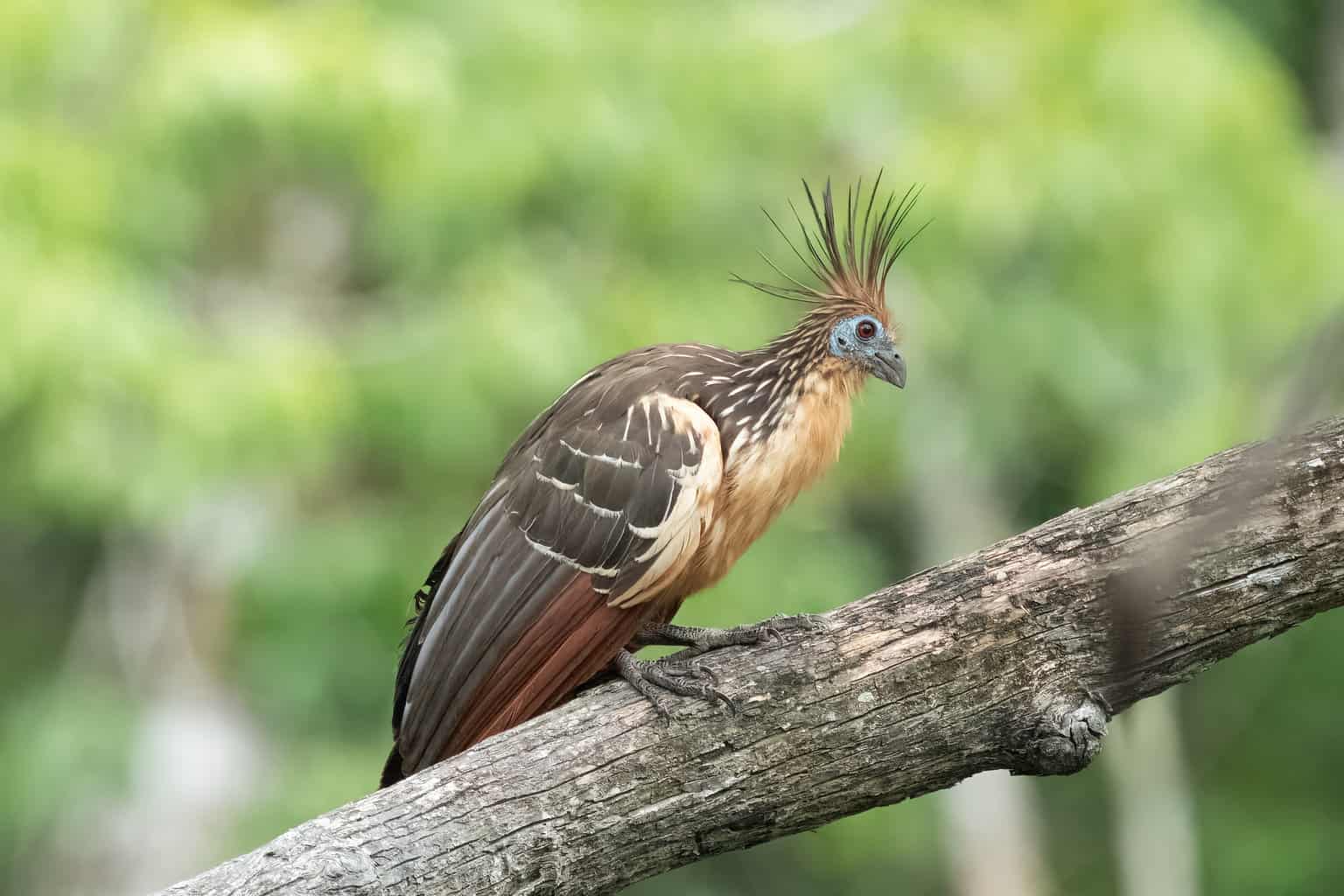The Hoatzin is a big, beautiful bird with a perpetual look of surprise on its face. It is definitely worth learning more about!
The Hoatzin (pronounced HWAT-sin) lives in the Amazon Basin and is best known for having quite a lot in common with–wait for it–cows!
Here’s the story…
What Does a Hoatzin Look Like?
The Hoatzin is about the size of a chicken or large pheasant.
It has a blue face, maroon eyes, and an orange crest that looks like a tall, dramatic mohawk.
Its chest and neck are orangeish, with deep chestnut-red underwing coverts and primary feathers and a dark brown back.
The Unusual Behavior of the Hoatzin
I once read someone describe the Hoatzin as a “dumpy” bird! Kind of a mean description, but it’s true that these birds are unusual in their behavior and appearance.
They tend to move clumsily down the waterways of the Amazon Basin. They live in large groups, so they make a lot of noise as they kind of flounder their way through the leaves.
What Does the Hoatzin Sound Like?
The Hoatzin has a variety of calls, including some groaning, croaking, hissing, and grunting.
Their vocalizations tend to be hoarse, and they make a lot of their sounds while moving their bodies.
Check out a variety of their sounds here:
What Makes the Hoatzin Like a Cow?
Hoatzins, cows, goats, and sheep are all ruminators. That means that to digest their food in their gut, they need bacteria to ferment their food.
In a mammal, ruminators have a “rumen” in their gut–a sac that is specialized to aid in the bacterial fermentation process.
The Hoatzin is the ONLY bird that has this trait. It has an enlarged esophagus and crop. These “foregut compartments” digest the food before it goes into the stomach. There are more than 1000 kinds of bacteria found in the crop of a Hoatzin!
These bacteria have an unpleasant side effect though. During the 45 hours that it takes for this digestion process to take place, an unpleasant odor is released–which is the reason why the Hoatzin gets the nickname “the stinkbird.”
Evidently, this odor is similar to cow manure. (Something else they have in common with cows, I suppose!)
While digesting, Hoatzin just kind of lay around. They have to stay mostly still while their crop does the work of bacterial fermentation.
What Does the Hoatzin Eat?
The Hoatzin is the only bird in the world that eats a diet exclusively made up of leaves. That means no nuts, seeds, or insects–just leaves!
Their strong preference is for younger leaves, shoots, and buds. They need high nitrogen and low fiber plants.
Other Interesting Facts About the Hoatzin

The Hoatzin is also unique in a few other features.
For example, their babies hatch with two claws on each wing that later fall off when they are about 3 months old. Some scientists believe that the claws may link the Hoatzin to the ancestor of many birds, the Archaeopteryx.
Other researchers believe that this is a newer adaptation, rather than a very old one. Perhaps it is an adaptation based on the need to hold onto the nest or the side of the water when they flee predators.
Their predators include monkeys, other mammals, and birds of prey like hawks, falcons, and eagles.
Also, an adult Hoatzins builds its nests on branches that stretch out over bodies of water, which means that the hatchlings will jump into the water when a predator attacks the nest–and swim to safety.
Finally, Hoatzins are the only surviving member of the Opisthocomidae family, meaning that they have no other close relatives. It’s likely that the Hoatzin family tree separated from other birds about 64 million years ago!
They are an evolutionary mystery that scientists are still trying to figure out.
Does the Hoatzin Migrate?
They are mostly non-migratory birds. In fact, they are such poor fliers that they rarely travel very far at all.
Where To Find a Hoatzin:
Hoatzins do not live well in captivity. The best option for observing these stinky, fascinating birds is to travel to South America.
They live in Peru, Brazil, Columbia, Ecuador, Venezuela, and other tropical South American nations.

